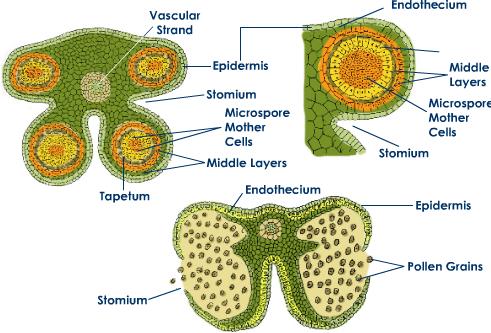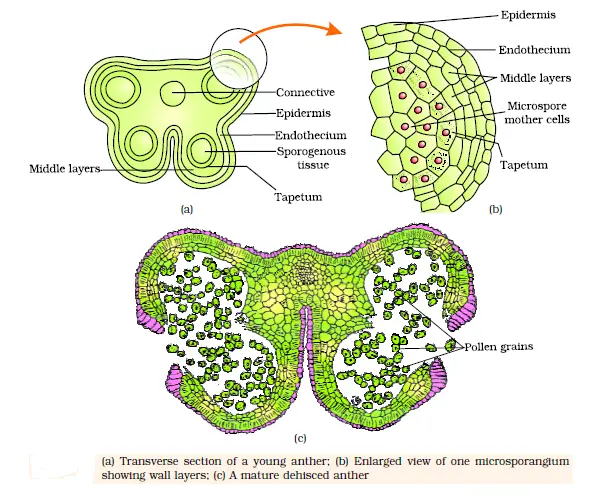What is a Bilobed Anther?
- The bilobed anther is a critical component of the stamen, the male reproductive part of flowering plants, primarily angiosperms. Its primary function is to produce and release pollen, which is essential for the fertilization process in plants.
- Structurally, a bilobed anther consists of two distinct lobes, each containing two microsporangia, commonly referred to as pollen sacs or thecae. These pollen sacs are where pollen grains, the male gametophytes, develop and mature. The bilobed structure is typical in most angiosperms, where the anther is described as dithecous, indicating the presence of two thecae per lobe.
- During the development of the anther, the pollen sacs within each lobe are initially separated by a septum. However, as the anther matures, the septum disintegrates, allowing the two sporangia within each lobe to merge. This merging is crucial for the dehiscence process, where the anther opens along a longitudinal slit known as the stomium to release the mature pollen grains.
- The release of pollen is a vital process in the reproductive cycle of flowering plants. Once the pollen is released, it is transported, often by wind, water, or pollinators, to the stigma of a compatible flower’s pistil. This transportation allows for fertilization, leading to the development of seeds.
- In some plant species, like those in the Hibiscus and Cotton genera, the typical bilobed structure is replaced by a single-lobed anther. Despite this variation, the fundamental function of producing and dispersing pollen remains consistent across different plant species.
- Overall, the bilobed anther plays a pivotal role in the reproductive success of flowering plants, ensuring the continuation of plant species through efficient pollen production and dispersal.
Structure of a Bilobed Anther
The structure of a bilobed anther is essential to understanding its role in plant reproduction. Here’s a detailed breakdown of its components:

- Filament:
- The anther is supported by a slender stalk known as the filament.
- The filament’s primary function is to transport water and nutrients to the anther, enabling the production of pollen.
- Bilobed Structure:
- The anther is described as bilobed, meaning it has two distinct lobes.
- Each lobe contains two microsporangia, which are the sites where pollen grains develop.
- Therefore, a bilobed anther is tetrasporangiate, possessing four microsporangia in total.
- Thecae:
- Inside each lobe, there is a cavity called the theca, which houses the microsporangia.
- The theca serves as the storage area where pollen grains are nurtured until maturity.
- Connective Tissue:
- The two lobes of the anther are connected by non-sporangial tissue known as the connective.
- The connective includes a single vascular strand, which supplies nutrients and support to the anther structure.
- Intersporangial Septum:
- Within each lobe, the two microsporangia are separated by a sterile tissue layer called the intersporangial septum.
- As the anther matures, enzymatic processes cause the lysis of the septum, allowing the sporangia to merge into a single locule or theca.
- Variations in Anther Structure:
- While most angiosperms exhibit a bilobed structure, some plants, like Hibiscus rosa-sinensis, display a monothecal anther, characterized by a single lobe containing two microsporangia.
- These microsporangia fuse at maturity to form one theca, differentiating monothecal anthers from the more common bilobed type.
- Anther Shapes:
- Anthers can vary significantly in shape across different plant species.
- Common shapes include linear (e.g., in Acalypha), rounded (e.g., in Mercurialis), sagittate (e.g., in Vinca), sinuous (e.g., in Cucurbita), and reniform (e.g., in the China rose).
Transverse cross-section of a Bilobed Anther
A transverse cross-section of a bilobed anther provides a detailed view of its internal structure, revealing multiple layers that play essential roles in the development and release of pollen. The anther wall is composed of four distinct layers, each contributing to the anther’s overall function.

- Epidermis:
- The outermost layer of the anther, the epidermis, serves as a protective barrier.
- It prevents water loss and provides structural support to the anther.
- The epidermis is crucial during anther dehiscence, the process by which the anther releases pollen.
- The point where dehiscence occurs is called the stomium, and this can be positioned longitudinally, transversely, apically, or in a valvular manner.
- In the stomium region, epidermal cells differentiate into specialized cells that facilitate the opening of the anther at maturity, allowing pollen to be dispersed.
- Endothecium:
- Situated beneath the epidermis, the endothecium is often referred to as the hypodermal layer.
- This layer is typically single-layered and located in the protruding parts of the anther.
- As the anther matures, the cells in the endothecium elongate radially, aiding in the dehiscence process by providing the necessary tension to open the anther.
- Besides assisting in dehiscence, the endothecium also adds structural support to the anther.
- Middle Layers or Intermediate Layer:
- The middle layer, also known as the intermediate layer, generally consists of one to three layers of cells.
- These cells are thin-walled and store food materials such as starch, which nourish the developing microspores.
- During pollen development, the stored food in the middle layer is mobilized to support the growth of microspores.
- However, the middle layers are short-lived and are typically crushed during the meiotic division of microspore mother cells, contributing to their eventual disintegration.
- Tapetum:
- The tapetum is the innermost layer of the anther wall, encircling the sporogenous tissue where pollen grains are formed.
- It plays a critical role in pollen development by secreting essential hormones and enzymes required for the growth and maturation of pollen grains.
- In many angiosperms, the tapetum is derived from both the parietal layer (forming the outer part) and the connective tissue (forming the inner part).
- As micro-gametogenesis progresses, the tapetum begins to degenerate and is fully degraded by the time of anther dehiscence, ensuring that mature pollen grains are ready for release.
Functions of a Bilobed Anther
The bilobed anther, a crucial component of angiosperm reproduction, serves multiple functions that are integral to the fertilization process in plants. Below are the key functions of a bilobed anther:
- Pollen Production
- The primary function of a bilobed anther is the production of pollen grains, also known as microgametophytes. Within each lobe of the anther, microsporangia, or pollen sacs, are present, where microsporocytes undergo meiosis to form haploid microspores. These microspores then undergo mitotic divisions to develop into mature pollen grains, which carry the male gametes necessary for fertilization.
- Pollen Maturation
- As the microspores develop into pollen grains, the anther supports their maturation process. This includes the transformation of microsporocytes into microspores and their subsequent development into fully formed pollen grains. The anther’s internal environment provides the necessary conditions for this critical phase, ensuring that the pollen grains are viable for successful reproduction.
- Pollen Storage
- The bilobed structure of the anther allows for efficient storage of pollen grains within the microsporangia. The pollen grains remain stored in these sacs until they are fully mature and ready for dispersal. This storage function ensures that pollen is available in large quantities when conditions are favorable for pollination.
- Pollen Release
- Upon reaching maturity, the anther undergoes a process called dehiscence. During dehiscence, the anther splits open at a specialized region known as the stomium, allowing the release of the pollen grains. This mechanism ensures that the pollen is released at the optimal time for successful pollination.
- Pollen Dispersal
- The anther’s bilobed structure, combined with its strategic positioning on the filament, facilitates the effective dispersal of pollen. The height and location of the anther enable it to come into contact with pollinators, such as bees, or to release pollen directly into the air for wind dispersal. This ensures that the pollen grains are efficiently transported to the stigma of a compatible flower, leading to successful fertilization.
FAQ
What is a bilobed anther?
A bilobed anther is a type of anther in flowering plants that is divided into two lobes. It is an essential component of the male part of the flower, responsible for producing and releasing pollen.
What is the primary function of a bilobed anther?
The primary function of a bilobed anther is to produce, store, and release pollen grains, which carry male gametes necessary for fertilization in plants.
How does a bilobed anther produce pollen?
Inside the bilobed anther, pollen grains are produced in structures called microsporangia. Microsporocytes undergo meiosis to form haploid microspores, which then develop into pollen grains through mitotic divisions.
What is pollen maturation, and how does the anther facilitate it?
Pollen maturation refers to the process where microspores develop into fully mature pollen grains. The anther supports this process by providing the necessary environment and nutrients for the microspores to undergo development and differentiation.
How does a bilobed anther store pollen?
Pollen is stored in the microsporangia or pollen sacs within the lobes of the anther. This storage allows for a substantial quantity of pollen to be maintained until it is needed for release.c
What is the process of pollen release from the anther?
Pollen release, or dehiscence, occurs when the anther splits open at a region called the stomium. This process allows the pollen grains to be released into the environment.
Why is the position of the anther important for pollen dispersal?
The anther is positioned on a filament, which holds it aloft and facilitates its exposure to pollinators. This positioning increases the likelihood of pollen coming into contact with insects or wind for effective dispersal.
How do pollinators interact with the bilobed anther?
Pollinators, such as bees, visit flowers and come into contact with the pollen released from the anther. As they move from flower to flower, they transfer pollen to the stigma of other flowers, aiding in cross-pollination.
What happens if the anther fails to release pollen?
If the anther does not release pollen effectively, it can lead to reduced pollination and fertilization success. This can impact the plant’s ability to reproduce and produce seeds.
Are there any variations in the structure of bilobed anthers among different plant species?
Yes, the structure of bilobed anthers can vary among plant species. While they share the common feature of being divided into two lobes, the specific arrangement, size, and shape of the lobes can differ depending on the plant species.
- Text Highlighting: Select any text in the post content to highlight it
- Text Annotation: Select text and add comments with annotations
- Comment Management: Edit or delete your own comments
- Highlight Management: Remove your own highlights
How to use: Simply select any text in the post content above, and you'll see annotation options. Login here or create an account to get started.